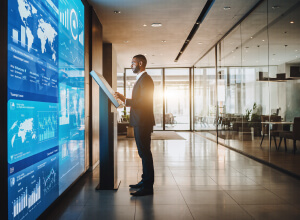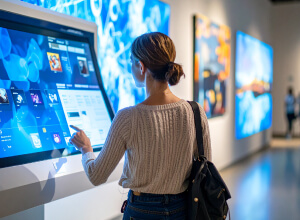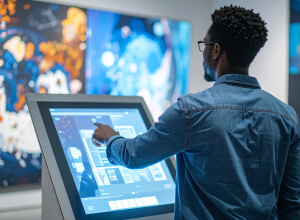7 Ways to Increase Kiosk Use in a Physical Place

Kiosks are becoming increasingly popular as a means of providing information and services in a variety of settings, including physical places such as stores, museums, and other public venues. While kiosks can offer a number of benefits, it can also be challenging to get people to actually use them. If you're looking to increase kiosk use in a physical place, there are a few things you can try.
1. Attract Attention to your Kiosk Machine
Consider your kiosk location
Kiosks are more likely to be used if they're located in a high-traffic area. Kiosk location is critical for maximum visibility. If you can, place your kiosk machine near the entrance or exit –whichever makes sense - of your store or venue. This will ensure that people see it and have the opportunity to use it.

To increase traffic to your self-ordering kiosks, consider adding printed signs in the store that tell customers where the kiosks are and what they do. A simple sign near the door saying "Try our new self-order kiosks" can help get attention, while additional signage near the actual machines with a phrase like "Just touch the screen to begin" will prompt customers to give them a try.
Decorate it
It's not only about the hardware; a great supplier will ensure that your kiosk enclosure stands out. To make your kiosk more appealing and represent your brand's personality, liberally use graphics and other design elements. You may also utilize LEDs or other visual and auditory cues to adorn your kiosks and attract attention.

Use Attract loops
Attract loops are videos typically no more than 30 seconds in length and feature interesting or eye-catching visuals. They're designed to grab the attention of passersby and lure them into using the experience. Depending on the suitability of the environment, the addition of compelling audio would increase an audience’s awareness, generating a much larger number of views than if posted silently.
Deloitte's Exponential Manufacturing attract loop
Add Music to your kiosk
Speaking of sound, music may be an excellent method to pique people's interest and draw visitors to your kiosk, even without an attract loop. Kiosk music is a wonderful approach to create a mood and get people talking. You can utilize music to establish the tone for your kiosk and make it more interesting.
2. Onboarding the staff about your interactive kiosk
Make sure objectives are aligned with the store manager
It’s important to make sure that the staff/ team is on board and that the goals of the interactive kiosk are aligned with the store operator. This will ensure that everyone is working towards the same objectives and that there is a clear understanding of what needs to be done in order to generate sales. The last thing a store needs is employees who do not understand the kiosk’s intent or outright reject its presence.
Train Staff
It's also important that your staff is trained on how to use the kiosks. They should be able to answer any questions that customers may have about the kiosk and its features. In addition, they should be able to help customers troubleshoot if there are any problems.
Employee assisted interactive kiosks for Sedalmerck - Credits to Fan Factory
3. Design your Kiosk Interface Efficiently With The Best Kiosk Software
Make it user-friendly.
People are more likely to use a kiosk if it's easy to use. If your kiosk is complicated or hard to navigate, people will be less likely to use it. Try to keep your kiosk interface simple and straightforward so that people can easily find what they're looking for.
Make sure your kiosk has a clear call to action, such as "Scan your loyalty card here" or "Press here to buy tickets." This will make it easier for people to use the kiosk and make it more likely that they'll use it again in the future.
Check out our free ebook, 10 Design Principles You Need to Know when Creating Multi-touch experiences
Consider Kiosk Accessibility
Also, make sure the kiosk is accessible for everyone, regardless of ability. Different people have different accessibility needs, so it's important to consider those when designing a kiosk.
For example, to achieve kiosk accessibility, the screen should be at a height that is easily reachable from even a seated height, and all the touchpoints should be positioned within easy reach. The kiosk installation should also be free of any obstructions that could prevent wheelchair users from accessing it.

The kiosk design itself must take into consideration factors such as a high color contrast to ensure color blind or otherwise visually impaired users can identify functional components, and all videos should have descriptions to make accessible kiosks for deaf and hard of hearing users.
Less is more using kiosk graphics
Try not to distract your users. If the kiosk is designed to aid with one fundamental activity, make sure it gets the job done well and effectively. Don't complicate things by providing too many choices from a single kiosk. Dedicated kiosks for clearly distinct activities such as ticket sales and customer feedback are good examples. This will lead to greater client satisfaction as well as more maintainable hardware and software than integrating numerous functions in one machine.
4. Offer incentives
Offering incentives, such as discounts or coupons, can be a great way to get people to use your kiosk.
People are also more likely to use a kiosk if it offers a service that's not available in the store, such as the ability to search for and order out-of-stock inventory (i.e. endless aisle). You can even offer products that are not available on the web, store exclusive items.
ANWB's endless Aisle Solution designed by Kega
Another incentive would be to offer loyalty points for use of the kiosk, which would be a great approach to getting people to come backand use it again.
5. More is better with multiple kiosk installations
A single, unattended kiosk in a physical location can give off an air of unimportance. How useful can the kiosk be if there is only one? And if that one kiosk is being used, why would another shopper wait? You should consider the value of having more than one kiosk vs. the cost of its deployment. By having multiple kiosk installations, more people are empowered to use your kiosk at the same time and you’ll be sending the message that your establishment felt the kiosks were critical for shopper satisfaction, encouraging interaction.
The Rocks Discovery Museum uses multiple kiosks for its interactive exhibit.
6. Avoid the Blue Screen of Death (BSoD) on kiosk and digital signage displays
You've undoubtedly seen kiosks or digital signage displays with a big system error message on the screen instead of the intended content. This is mortifying for kiosk owners, and it happens when the systems haven't been properly configured to restart applications in the event of an issue and conceal visible parts of the operating system.

High-end digital signage platforms like Intuiface include device management capabilities so you can keep tabs on the health of each player. You'll also get notifications if any players go offline, and – in the case of Windows PCs - you can remotely reboot devices and auto-launch content to overcome unexpected crashes.
7. Track kiosk usage with analytics
Make sure your kiosks come with some form of analytics that enables you to track your kiosk usage and content popularity. This can be helpful in understanding how people are using your kiosk and what improvements can be made.
By analyzing the data, you can make changes to improve accessibility or the overall user experience. Kiosk usage data can include items such as the average time spent at the kiosk, the number of interactions, and the most popular features or products.
For example, Blue Rhine developed a Store of the Future for Majid Al Futtaim, a Dubai-based holding company, where analytics are used to build a back-of-house dashboard for pick-and-learn and smart mirror installations. Read full success story here
Kiosks can provide a valuable service for customers if they are designed well and offer the right incentives. Placing multiple kiosks in strategic locations can help increase their usage, and ensuring that the system is stable and easy to use will minimize frustration for users. Tracking analytics can help you understand how people are using your kiosk and make necessary adjustments. By implementing these tips, you'll be able to increase sales and improve the customer experience with kiosks in your store.





